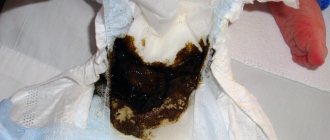The texture, smell, and color of stool can indicate a person's health. Therefore, when the stool suddenly turns black, this is a reason to think about the reasons for this phenomenon. Perhaps this is due to ordinary and harmless things. For example, by eating certain foods.
But it happens that black stool in a child indicates serious illnesses that require emergency medical intervention. There are also a number of chronic diseases and conditions where blackened stool is a dangerous and very suspicious symptom.
The normal color of stool ranges from yellow-brown to dark brown, and varies slightly. It depends on eating habits and personal characteristics of the body. The final color is formed due to the presence in the stool structure of products processed by intestinal bile and undigested food particles that made up the diet of a particular person in the last few days.
Normal baby stool
A breastfed baby's stool is yellow or slightly green and has a soft texture. It can be quite liquid, with a consistency similar to porridge. There are many normal shades of baby stool. One of them is a greener tint, which means that mom ate something not entirely typical of her diet. When your baby has no other symptoms, there is no reason to worry.
As a rule, every parent knows what stool color is normal for their child. Therefore, when the stool becomes unusual, it is impossible not to notice.
Black stool in a newborn
The very first thick, black, sticky deposits in a baby's diaper are far from the feces that will come later.
Your baby's first stool is called meconium. Meconium fills the intestines of all newborns. It gets its distinct color from bile, a fluid produced in the liver that aids digestion. In addition to bile, meconium contains amniotic fluid, lanugo (the fine hair that covers your baby's body while inside the uterus), dead skin cells, mucus and bilirubin. Most of these ingredients are harmless, but too much bilirubin in the blood can lead to jaundice.
Meconium stool is quickly replaced by transitional stool 3 to 5 days after birth. This stool is a little weaker and more greenish-brown in color. It is a “transition” to regular milk stool, which can be seen around the sixth day.
If your baby's stool is still black even after three days, or after transitional stool after five days, it may be a sign that the baby is not getting enough food and you should talk to your pediatrician right away.
A one-year-old's stool that looks black, tarry, or bloody can be quite scary for parents, but does not always indicate a serious illness.
Food
You don't have to worry about the occasional black stool. Black stool does not always mean there is blood in it. The color change can only be associated with the diet of a small child. Red beets, prunes, pomegranates, red grapes, black currants, blueberries and other fruits, berries, and vegetables can change the color of the stool. It is enough to stop eating these foods, and after a couple of days the feces will acquire a normal, familiar color.
Don't worry if you have normal-colored black inclusions in your stool—these are simply undigested food particles that have changed color in the digestive tract.
A common cause of intense concern is the presence of inclusions in the stool that look like small black worms. They are usually confused with worms and go to doctors to get tested and begin deworming. It is more likely that this is fiber from a banana eaten earlier. Real parasites have a completely different color - white or yellowish.
Medicines
Black stool may suddenly appear in an infant after taking certain medications. For example, medications used to prevent and treat anemia include iron, which gives stool that color. Vitamin complexes, medications with bismuth, and activated carbon have the same effect.
If you find that your child has black stools after using any medications, you need to carefully read the instructions for them.
It should be noted that drugs containing acetylsalicylic acid, as well as some anti-inflammatory drugs (Ibuprofen, Diclofenac) and anti-clotting agents, cannot stain the stool itself. However, their use sometimes causes internal bleeding.
Therefore, if you find black stool in a child, especially in the form of diarrhea, during treatment with these drugs, you should immediately seek medical help.
Bile
Sometimes the color of the stool is not black, but it appears so in poor lighting. This usually occurs when the baby has dark green stools due to bile and may look very dark. If this is the case, you can confirm your doubts by rubbing a piece of stool on something white or looking at it more closely under a bright light.
Gastrointestinal bleeding
When a child experiences other symptoms along with blackened stools - fever, pain, prolonged anguished crying, vomiting - this indicates bleeding in the upper gastrointestinal tract.
Various reasons that can cause bleeding:
- stomach ulcer;
- gastritis;
- Mallory-Weiss gap;
- foreign body or organ injury;
- intestinal ischemia (when blood does not properly supply the intestines);
- vascular malformation.
Every parent, when they notice black stool in their baby, begins to worry about what is causing these changes. Don't panic in advance.
Carefully study your child's diet over the past few days. If the food products mentioned above (beets, currants, pomegranates, etc.) were present, then more than likely they were the ones that colored the stool an unusual black color. Perhaps the reason is the use of certain medications (they were also mentioned earlier). In the case where the child has recently eaten regular foods and has not taken any medications, suddenly blackened stools are likely to indicate the occurrence of a life-threatening condition. And a visit to the doctor cannot be postponed.
Monitor the texture and color of your stool for several days. If the causes are harmless and not dangerous (for example, the use of certain foods and medications), then the stool returns to normal no more than 2 days after eliminating them. In cases where the feces have turned black due to serious illnesses, this will not happen.
Pay special attention to a child whose stool suddenly turns black. Does your baby look sick? How had he been feeling in the weeks and months prior to the blackening of his stools?
When the causes of blackening of the stool are harmless, the child’s well-being does not change, he feels healthy and full of energy. When the occurrence of black feces is accompanied by constipation, bloating, vomiting, nausea, anemia, heartburn, abdominal pain and other suspicious painful signals, the intensity of which increases over time, it is most likely that this is a serious disease or its complications.
When to seek medical help?
Black stool in babies is not necessarily a sign of illness, but you should talk to your doctor if the problem persists. The color usually returns to normal after a few days, but if it doesn't, it's time to see a doctor.

The doctor will confirm whether there is indeed blood in the stool. The specialist will also examine the outside of the anus to determine the true cause of the bleeding. Sometimes a rectal examination is performed to confirm the diagnosis.
Your doctor may recommend further testing if you are unsure about the cause of the bleeding. A colonoscopy will be ordered to examine the interior of the lower intestine.
Why can a baby's stool be so rare?
Problems with stool in artificial infants may be due to the fact that the composition of their feces is close to that of an adult, and the intestines are not yet accustomed to such a volume and must be emptied approximately once every day or two. Less often - already constipation.
Breasts differ significantly in this regard. Nature prepares human milk from blood and lymph; it is almost completely absorbed by the child and is not “discarded.”
However! Stool retention can also be caused by Hirschsprung's disease. It occurs extremely rarely - in one in five thousand newborns, but it is important to remember. Therefore, if the baby is restless and has prolonged stool retention, you should consult a pediatrician to rule out this pathology.
Watch the course “Baby Colic: A Cheat Sheet for Mom” (free in ViLine.Club)
Other facts about baby chairs that parents should know
Black stool in babies is a concern for parents, but from time to time you may notice other changes in the consistency and color of the stool.
Red chair
This is usually blood, so it makes sense to talk to your doctor, especially when this change persists. The baby may have a small crack on the inside of the anus when hard stool passes through, sometimes causing bleeding. If this is the case, your doctor will recommend drinking more fluids, prunes, and fiber to soften your stool.
Red stools may be the result of taking antibiotics that combine with iron.
Certain foods and drinks, such as red juice, can cause stool to appear colored.
Green chair
Green stool is usually the result of stool moving too quickly through a baby's intestines. This is not a cause for concern, especially in infants. But the child must gain weight well.
Green stool can also be the result of eating a lot of fiber foods (broccoli or other green vegetables). In some cases, the green color is due to the use of dyes in the food or drinks that the child consumes.
Yellow chair
In addition to black stools, the child sometimes has yellow stools. Don't worry about yellow stool if you are breastfeeding. Sometimes it looks like mustard in the diaper after feeding.
But consult a specialist if yellow stools are accompanied by abdominal pain. This may be due to inflammation or irritation in the intestines.
White chair
While gray or chalky stools are usually not a sign of abnormality, they are often the result of the child eating something unusual. You should tell your pediatrician if this occurs repeatedly. Rarely, it is associated with liver problems or another medical condition.
Thus, black stool in itself is not dangerous. But this is a possible signal of serious diseases in the body that threaten life if timely help is not provided. On the other hand, this is often explained by the banal consumption of certain foods that turn the stool an unusual color. In any case, do not be squeamish when studying the condition of your child’s stool. Nature is intelligent - it has provided a whole system of signs and signals that make a person wonder whether his body is in order.
Why does my child have black stool?
There are many reasons for the appearance of dark stool in a child. Immediately after birth, on days 2-4, the newborn begins to have dark stool called meconium, or original feces. It is a mixture of mucus, hair, bile, amniotic fluid and intestinal epithelial cells. This mixture is formed as a result of the intrauterine ingestion of all these substances by the baby. In addition, the dark color of meconium is often due to the ingestion of blood by the child during its passage through the birth canal. The discharge of black stool is quite normal. After all the substances that he ingested during his life in the uterus are removed from the newborn’s body, his stool will normalize and become yellowish.
Also, black feces in a child can be caused by the following reasons:
- Introduction to the diet of a new infant formula that is fortified with iron. This reason should not be a reason for concern or cancellation of the artificial formula.
- Transferring the child to a mixed diet and introducing new complementary foods. In this case, the dark color of the stool is explained by the consumption of foods containing iron. The baby's digestive system is not quite ready to absorb iron, since before this he was fed only breast milk. After a certain time, the normal digestion process will improve, and the stool will acquire its usual color. Foods that can turn your baby's stool dark are liver, red grapes, beets, cherries, cherries, black currants, blackberries and blueberries. However, this condition is not a reason to discontinue the use of these products.
- Eating bananas for the first time in my life. When a baby is given bananas the first few times, small long black stripes may appear in his stool. This condition is not a pathology and will go away on its own as the digestive system gets used to bananas.
- Taking medications. Some medications can turn your baby's stool dark. Most often this occurs after taking vitamin complexes, activated carbon, and medications containing bismuth. After discontinuation of therapy with these medications, the color of stool is restored on its own.
- Bleeding in the gastrointestinal tract or upper intestine. In this case, the stool contains a large amount of blood, which on its way from the upper parts of the digestive system acquires a dark (black) color. Moreover, in addition to black feces, the child also exhibits other symptoms of pathology - a general deterioration in health, fainting, abdominal pain, nausea, vomiting, weakness, and increased body temperature. Bleeding can be caused not only by certain diseases of the gastrointestinal tract, but also by the child swallowing sharp objects.











